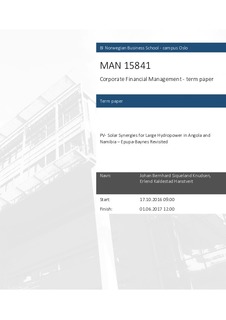PV- Solar Synergies for Large Hydropower in Angola and Namibia - Epupa-Baynes Revisited
Master thesis
Permanent lenke
http://hdl.handle.net/11250/2464252Utgivelsesdato
2017Metadata
Vis full innførselSamlinger
Sammendrag
This paper examines the financial viability for constructing and operating PV-solar in
tandem with hydropower within the context of Sub Saharan Africa using the Baynes
Hydropower Project on the border between Angola and Namibia as an example.
Specifically, the study re-examines the previous and current optimised installed
capacity at 360 MW and 600 MW with the option of a 50 MW floating PV-solar
plant on the reservoir created by the 200 meter high dam.
The motivational background is the increasing competition from other renewables,
particularly PV-solar in the traditionally hydropower dominated market. Whether
and to what extent this transition might influence the future development of
hydropower in the region is in addition to a brief review of the power sector (i.e.
market conditions) and resulting financial implications among the aspects that are
addressed.
In contrast to Angola, where electricity sector is in the process of adapting to increase
tariffs and performance standards toward financial sustainability, Nambia´s power
sector is more mature, is financially stable with electricity prices that albeit a slight
loss in 2016 largely reflect the actual cost of service. Bridging the widely different
political risk environments is a main challenge for securing financing at competitive
rates.
Using prevailing market prices for electricity in Namibia as a proxy for likely future
prices and simplified reservoir model to simulate power production, the results show
the impact of increasing installed turbine capacity and addition of PV-solar on tariffs
and revenue from power sales. PV-solar increases the financial viability in all cases.
However, marginal gains diminish with additional installed turbine capacity as well
as with PV-solar installation cost. At the cost of US$1.13/ W (56.5 million) for the
proposed 50 MW conjunctive PV-solar plant, the 360 MW with PV-solar emerge as
the favoured development alternative for equity holders and host governments.
Noting the prevailing uncertainty on development of market conditions the analyses
also estimates the option value of delaying investment in anticipation of higher tariffs
in the future. This uncertainty increases the value of the option to develop the project. Combined with higher variation in available flows due to climate change the
analyses illustrates the importance of diversification in the power system.
Given the reliability of financial assumptions (p 31) the risk mitigation capacity
remains as the most vulnerable factor. Currency risk has been hedged, and to some
extent passed on to governments and consumers. Others risks, like political and
macro-economic, remains but has been included in cost of capital calculations. These
risks have increased expected cost of capital, but no more than to a level where
internal rate requirements still can be met.
The importance of a healthy capital structure is a critical factor for Baynes. Even if a
tax-shield benefit would increase NPV at higher debt-ratio than the proposed 70%, it
is crucial for Baynes to raise enough equity. If not, we doubt the project´s ability to
raise sufficient debt capital. The necessary World Bank backed loan depends on
Baynes ability to show economic and financial credibility in a risk volatile
environment. Angola-Namibia government cooperation is the main factor in gaining
this credibility.
Beskrivelse
Executive Master of Management i Finansiell strategi fra Handelshøyskolen BI, 2017
